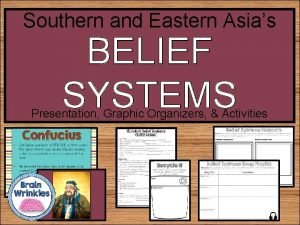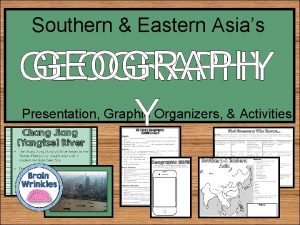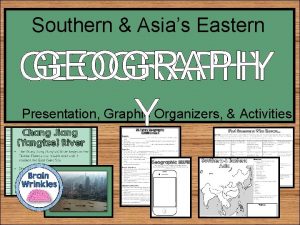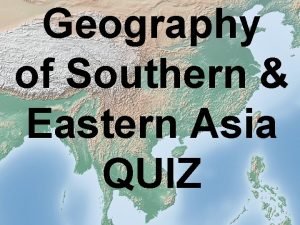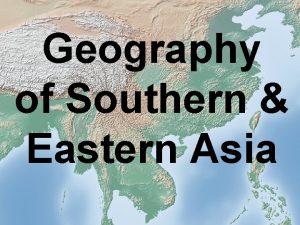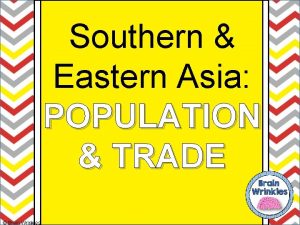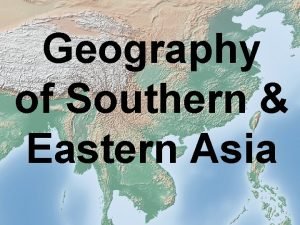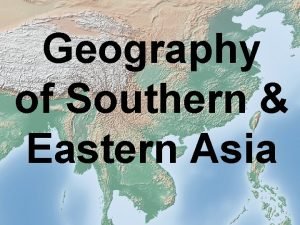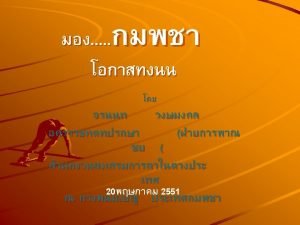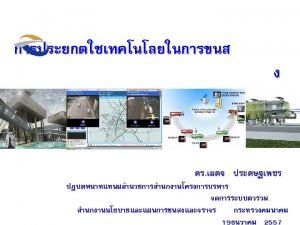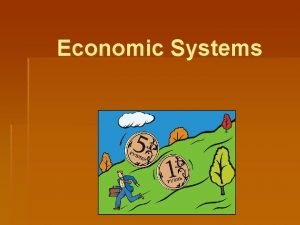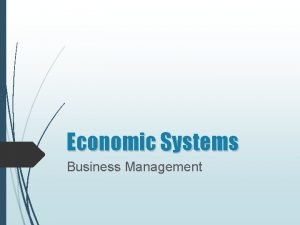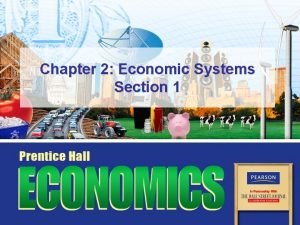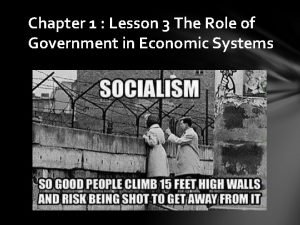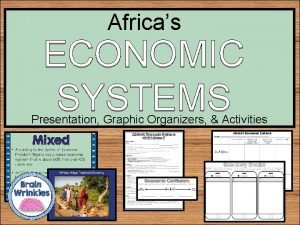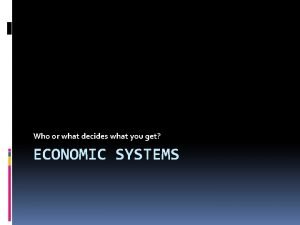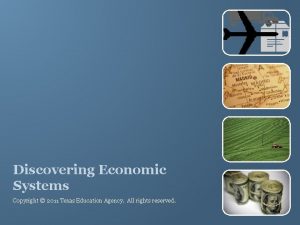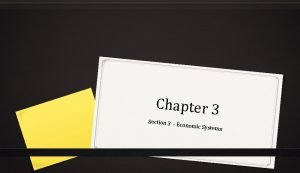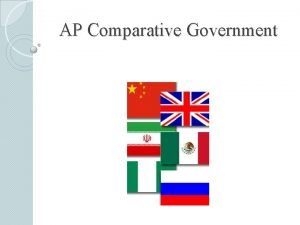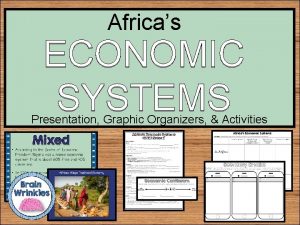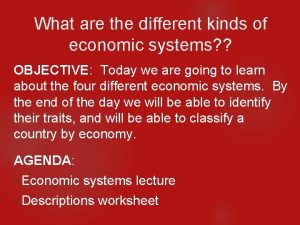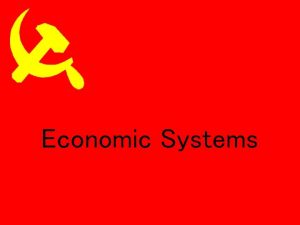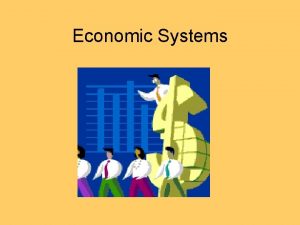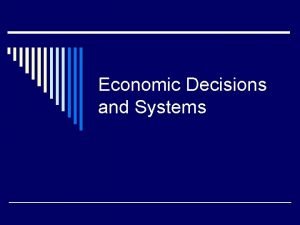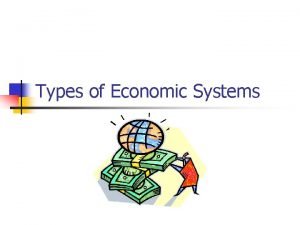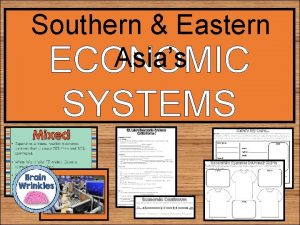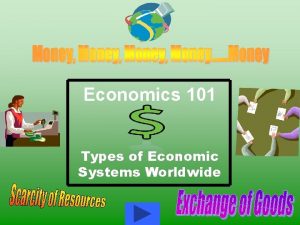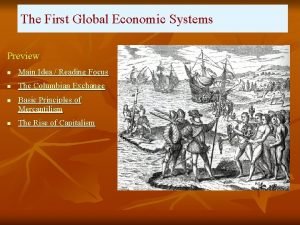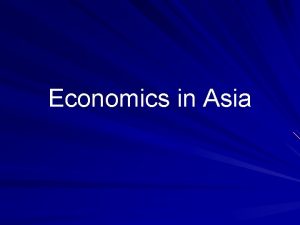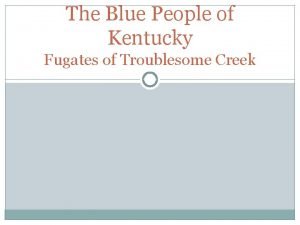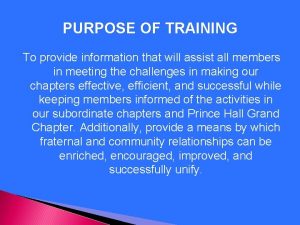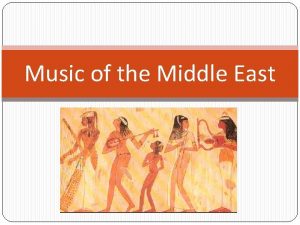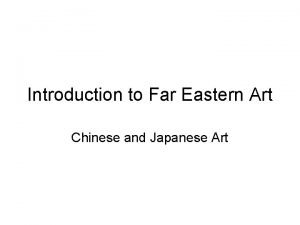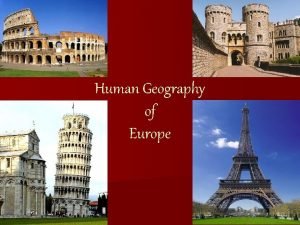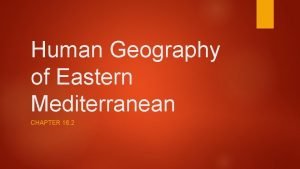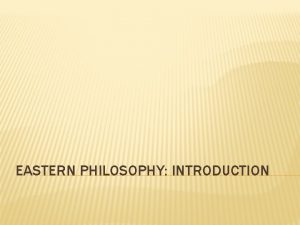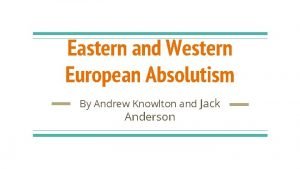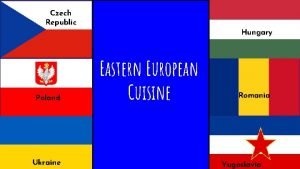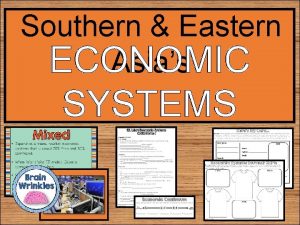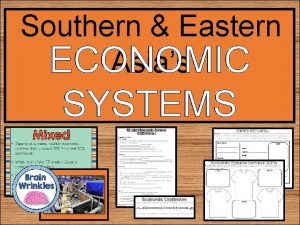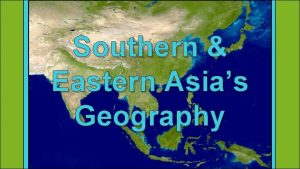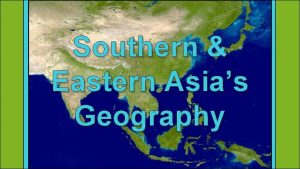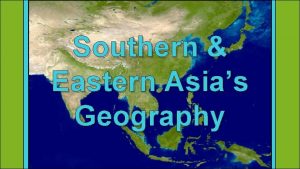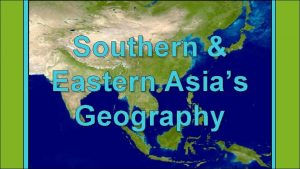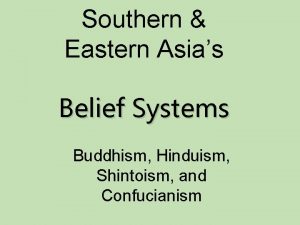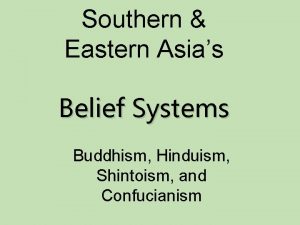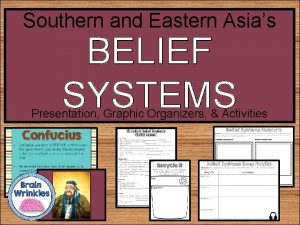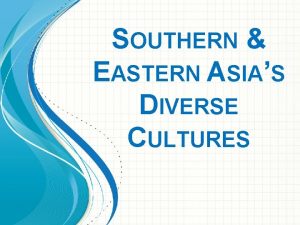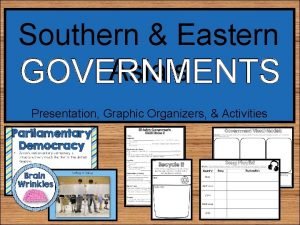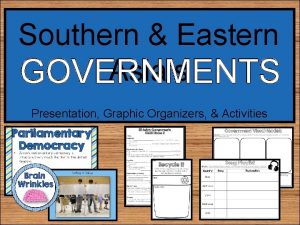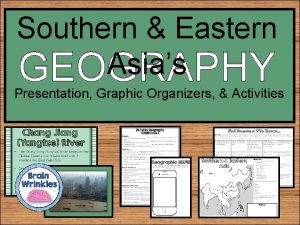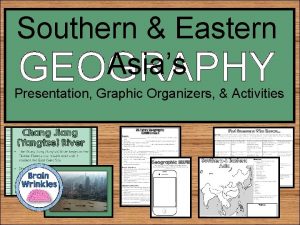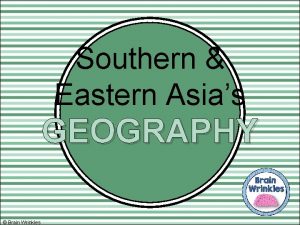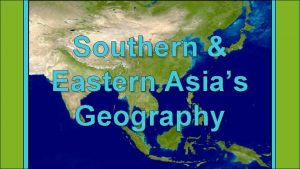Southern Eastern Asias ECONOMIC SYSTEMS STANDARDS SS 7





































































- Slides: 69

Southern & Eastern Asia’s ECONOMIC SYSTEMS

STANDARDS: SS 7 E 7 Analyze different economic systems. a. Compare how traditional, command, and market economies answer the economic questions of 1 what to produce, 2 -how to produce, and 3 -for whom to produce. b. Explain that countries have a mixed economic system located on a continuum between pure market and pure command. c. Compare and contrast the economic systems in China, India, Japan, North Korea, and South Korea. © Brain Wrinkles

Weekly Agenda: 3 -15 to 3 -19 -21 Weekly Opening: • Journal Writing • Citizenship Word of the Week: Honesty • Current Events • Government Visual Models Activity Weekly Work Period: • SE Asia’s Map Skills Review (Countries and Physical Features) (ongoing review of map skills) • SE Asia’s Economic Systems Cloze Notes Students will use the student’s Power. Point to complete cloze notes independently.

Weekly Agenda: 3 -15 to 3 -19 -21 Weekly Work Period cont’: • SE Asia’s Economic Systems Chart Activity Students will use guided notes to complete the chart. Once finished, we will check answers as a class. If time permits, students will color their pictures. • SE Asia’s Economic System Souvenir Shirt Activity The students will create t-shirts to showcase each country’s key economic details. The shirts should include symbols and images that represent the country’s system, freedoms, regulations, etc. The students will also write a brief description of each country’s economy in the textbox

Weekly Agenda: 3 -15 to 3 -19 -21 Weekly Closing: • SE Asia’s Economic Systems Comprehension Check Students will complete the assignment after discussing the presentation. This will count as a quiz! • SE Asia Economic Continuum Activity Students will label the line of economic continuum for SE Asia’s countries.

Weekly Assessment/Technology Tools: 3 -15 to 3 -19 -21 • SE Asia’s Government Assessment • SE Asia’s Economic Systems Comprehension Check • SE Asia’s Economic Continuum Activity • USA Testprep (graded assignment; class time is given but can be completed at home) • Edpuzzle Videos (graded assignment; class time is given but can be completed at home) • Discovery Education (graded assignment; class time is given but can be completed at home)

Journal Topics: 3 -15 -21 3 -16 -21 3 -17 -21 3 -18 -21 3 -19 -21 Student Holiday Bestie and Honesty Current Event Wednesday/CNN 10 Return the Money Is Honesty the Best Policy

Journal Topic: 3 -12 -213 -15 -21 Do the Thing "You must do the thing you think you cannot do. " Think about a time when you did something you thought you could not do. (5 or more sentences)

Journal Topic: 3 -16 -21 Bestie and Honesty Your “bestie”, since childhood, had on a new outfit. Your best friend adores it and asks if you like it. You think the outfit is ugly, but you don’t want to hurt your friend’s feelings. Write out what you would say, but maintain honesty. (5 or more sentences)

Citizenship: 3 -16 -21: Honesty is defined as truthfulness and sincerity. Talk about a time when being honest resulted in you being rewarded. https: //safeshare. tv/x/ss 5 bb 2267004 e 1 c#

Current Event Wednesday: 3 -17 -21 CNN 10 Three students will be randomly chosen to share out articles. Students who refuse to share out will lose points. (Each student must do one article per week and will receive a current event grade. ) https: //www. cnn. com/cnn 10

Journal Topic: 3 -18 -21 Return the Money You see your best friend take money from your teacher’s drawer. Persuade your friend to return the money. Give your friend some advice about honesty. (5 or more sentences)

Citizenship: 3 -18 -21: Honesty is defined as truthfulness and sincerity. Talk about a time you lost privileges or rewards because you were not honest. https: //www. youtube. com/watch? v=1 xp. Mwnu. M 8 ZU

Journal Topic: 3 -19 -21 Is Honesty the Best Policy There’s an adage that says “Honesty is the Best Policy. ” Is honesty always the best policy? Do you think that it is ok not to be honest sometimes. Explain. (5 or more sentences)

Citizenship: 3 -19 -21: Honesty is defined as truthfulness and sincerity. Discuss a time when you were not going to be honest, but decided to do the right thing. https: //www. passiton. com/inspirational-stories-tvspots/91 -classroom

Southern & Eastern Asia’s ECONOMIC SYSTEMS China, India, Japan, North Korea, & South Korea © Brain Wrinkles

ECONOMIC SYSTEMS © Brain Wrinkles

Let’s Review • Do you remember the three questions that every country must answer when developing its economic plan? 1. What goods/services will be produced? 2. How will goods/services be produced? 3. Who will consume the goods/services? • The way a country answers these questions determines its economic system

Traditional • This system answers the three economic questions based on traditional customs and beliefs of the past. • The values and traditions have been passed down from generation to generation. • Some rural villages in Asia have traditional economies where the people still follow the way of life of their ancestors.

Rice Village in SE Asia - Traditional Economy

Command • This system answers the three economic questions through strict government control. • The government regulates all of the country’s economic decisions: prices of goods, wages of workers, goods to be made, etc. • China’s Great Leap Forward was an example of a command system.

Communal Farming during the Great Leap Forward

Command • This system is very harsh to live under; because of this, there are no PURE command countries in the world today. • Some countries are close: Cuba, former Soviet Union, North Korea, former East Germany, etc. • All of these countries have the same type of government: Communist! The government is in control of everything.

North Korea’s Command Economy

Market • This system answers the three economic questions based on supply and demand in the market place. • The goods and services produced are determined by what the people want to buy and sell. • The government has no control over the economy; private citizens answer all economic questions.

Market • In a truly free market economy, the government would not be involved at all. Scary… • There would be no laws to make sure goods/services were safe. *Food! Medicine! • There would be no laws to protect workers from unfair bosses. • Because of this, there are no PURE market economies, but some countries are closer than others.

Mixed • Since there are really no countries with either a “pure command” or a “pure market” economy, what does that make them? • Most democratic countries have some characteristics of both systems, so we keep it simple and call them: MIXED.

Mixed • Their economies are not run entirely by government commands, nor do they side with the free market 100% of the time— they are somewhere in between. • Of course, most countries’ economies are closer to one type of system than another.

North Korea’s Command Economy

SE Asia • Most countries in Southern and Eastern Asia have mixed economies; however many of them have a high level of government involvement that leans closer to command than to market. • Strictly-controlled prices and governmentowned industries are common throughout the region, especially in China and North Korea. • On the other hand, the region also has some countries with very free economies, like South Korea and Japan.

CHINA © Brain Wrinkles

Mixed • China has a mixed economic system that is about 57% free and 43% command. • China is transitioning from a command economy controlled by the communist Chinese government, towards a mixed market one with more economic freedom for individuals. • Since China started loosening up the centrally planned economy in the 1970 s, private companies have produced much more of China’s growth.

© Brain Wrinkles

Growth • China’s economy is the fastest-growing economy in the world, as well as the largest economy in the world. • Economists predict that within the next twenty years, China will lead the world in economic strength.

© Brain Wrinkles

© Brain Wrinkles

Freedom • Throughout the past several decades, China has transitioned away from a centrallyplanned command economy and is moving more towards a free market one. • China’s national government has let more and more citizens and private corporations take over industries that it previously owned. • The government has also allowed farmers to make their own decisions regarding crops, rather than collectively farm.

© Brain Wrinkles

Freedom • The government has loosened its control and now encourages competition among businesses, which has helped the economy grow. • Today, Chinese companies have more power to set prices of their goods based on supply and demand of the market. • China’s government has also allowed businesses to raise their own money through investments made in a stock market.

© Brain Wrinkles

Regulation • While private enterprise is playing a larger role in China’s economy, the national government is still extremely influential in the country’s economic planning. • The biggest companies in China are all stateowned. • The government operates industries like banking, oil, airlines, and telecommunications. • It also charges high taxes in order to pay for infrastructure and social services.

© Brain Wrinkles

INDIA © Brain Wrinkles

Mixed • India has a mixed economic system that is about 53% free and 47% command. • When India gained independence in 1947, its government set up a command economy and controlled all industries and production. • Since the early 1990 s, the government loosened some of its control and has allowed private businesses to participate in

Freedom • Over the past thirty years, India’s national government has let more and more citizens and private corporations take over industries that it used to own. • Private businesses now have the ability to decide how much of a good to produce and to set their own prices. • In addition, in order to promote entrepreneurship, the government provides support to new business owners with training, facilities, and loans to get started.

Small-scale Garment Factory in India © Brain Wrinkles

Growth • Since the government has loosened its control , India’s economy has been growing rapidly and is now ranked the 7 th-largest economy in the world. • Because of its large, educated population, India has developed prosperous information technology and software services industries. • Unfortunately, although the transition from a command to a more market system has been good for India’s economy, millions of Indians still live in poverty.

Engineering Technology Education in India © Brain Wrinkles

Regulation • India’s government is still very active in its economy. • The government imposes high taxes on private businesses, subsidies on goods in the private sector, and tariffs on imported goods. • A number of industries are state-run, while the government is partially involved in others. • Strict government regulations make

JAPAN © Brain Wrinkles

Mixed • Japan has a mixed market economic system that is about 70% free and 30% command. • When World War II ended, Japan’s economy was crushed. • Since then, the Japanese government has worked hard to build a modernized economy that is based mostly on free market ideas.

© Brain Wrinkles

Freedom • In Japan’s mixed market economy, private businesses and individuals have the ability to set their own prices and to decided how much to produce based on supply and demand. • Japanese businesses and citizens own much of the land, resources, and factories.

Regulation • Japan’s government owns few companies other than the country’s major television network, but it does regulate some aspects of the economy like banking and trade. • It also imposes taxes on businesses and citizens and places quotas or tariffs on imports. • Japan’s government also screens foreign investments, which foreign governments have complained about for many years.

NORTH KOREA © Brain Wrinkles

Command • North Korea’s economy is only 5% free and 95% controlled. • Economists say it is a fully command economic system. • North Korea’s economy is the most government-controlled and repressed in the world.

Freedom? • Private businesses and citizens have no real role in North Korea’s economy. • In fact, entrepreneurship is considered illegal. • The Communist central government makes all economic decisions about what to produce, how much to charge, and for whom.

North Korean Factory Inspection © Brain Wrinkles

Regulation • North Korea’s government regulates its economy without any input from private citizens. • It controls how food is distributed to the people. • It owns almost all property and resources. • The government also blocks almost all foreign businesses from investing (or helping).

Farm Inspection © Brain Wrinkles

Growth? • Having so much government control has not allowed North Korea’s economy to grow or innovate. • North Korea has not had positive economic growth since the early 1990 s. • The country’s agriculture does not produce enough to feed the population, so the country is forced to receive aid from other countries in order to avoid famine.

Growth? • Factories, machinery, and equipment are severely outdated because the government has invested heavily in the military rather than the economy. • North Korea would not be prepared to join the world economy even if other countries wanted it to. • Most countries (other than China) refuse to trade with North Korea because of its strict government and history of aggression.

Outdated Tractor Simulator – How North Korea trains future farmers. © Brain Wrinkles

SOUTH KOREA © Brain Wrinkles

Mixed • South Korea has a mixed economic system that is about 74% free and 26% command. • In the 1970 s, South Korea’s democratic government partnered with private companies on economic decisions. • This has led to rapid economic growth for South Korea. • Today, the country has a highly industrialized economy that leans towards a free market system.

© Brain Wrinkles

Freedom • Private businesses and citizens have played a large role in the growth of South Korea’s economy. • They are able to set prices and decide how much to produce based on supply and demand without much government interference. • South Korea’s government supports entrepreneurship, and overall business freedom ranks at 91%.

Regulation • In order to pay for state services and infrastructure, South Korea’s government charges taxes on businesses and citizens. • Even though most of the former state-run industries have privatized, the government still runs the real estate, energy, railroad, and road construction sectors.

Thank You! Thank you so much for downloading this file. I sincerely hope you find it helpful and that your students learn a lot from it! I look forward to reading your feedback in my store. If you like this file, you might want to check out some of my other products that teach social studies topics in creative, engaging, and hands-on ways. Best wishes, Ansley at Brain Wrinkles
 What is asias largest desert
What is asias largest desert Se asia's belief systems cloze notes
Se asia's belief systems cloze notes Southern and eastern asia map
Southern and eastern asia map Se asia geography cloze notes 1 answer key
Se asia geography cloze notes 1 answer key Southern and eastern asia physical features answer key
Southern and eastern asia physical features answer key Southern and eastern asia physical features
Southern and eastern asia physical features Se asia geography cloze notes 1
Se asia geography cloze notes 1 Brain wrinkles southern and eastern asia
Brain wrinkles southern and eastern asia Southern and eastern asia physical features map answer key
Southern and eastern asia physical features map answer key Southern and eastern asia physical features answer key
Southern and eastern asia physical features answer key Economics unit 1 lesson 2 difficult choices
Economics unit 1 lesson 2 difficult choices Southern economic corridor
Southern economic corridor Southern economic corridor
Southern economic corridor Economic growth vs economic development
Economic growth vs economic development Economic growth and development
Economic growth and development Factors necessary for service standards are
Factors necessary for service standards are Education health and famine comprehension check
Education health and famine comprehension check What economic system is germany
What economic system is germany How many economic systems are there
How many economic systems are there How many economic systems are there
How many economic systems are there Chapter 2 economic systems and decision making
Chapter 2 economic systems and decision making Traditional economy cartoon
Traditional economy cartoon Chapter 2 economic systems answer key
Chapter 2 economic systems answer key Chapter 2 economic systems and decision making
Chapter 2 economic systems and decision making Chapter 2: economic systems worksheet answer key
Chapter 2: economic systems worksheet answer key Lesson 3 the role of government in economic systems
Lesson 3 the role of government in economic systems Africa's economic systems cloze notes 1
Africa's economic systems cloze notes 1 Who or what decides what you get?
Who or what decides what you get? Topic 2 free enterprise and other economic systems
Topic 2 free enterprise and other economic systems Discovering economic systems comparative worksheet answers
Discovering economic systems comparative worksheet answers The three economic systems
The three economic systems Economic systems
Economic systems Africa's economic systems cloze notes 1
Africa's economic systems cloze notes 1 Chapter 2 economic systems and decision making answer key
Chapter 2 economic systems and decision making answer key Command economy pros
Command economy pros Traditional economy strengths and weaknesses
Traditional economy strengths and weaknesses What do economic systems seek to do?
What do economic systems seek to do? Chapter 1 economic decisions and systems answer key
Chapter 1 economic decisions and systems answer key Economic systems
Economic systems Economic systems chart
Economic systems chart Market economy
Market economy The first global economic systems answer key
The first global economic systems answer key What do economic systems seek to do?
What do economic systems seek to do? Decision support systems and intelligent systems
Decision support systems and intelligent systems Dicapine
Dicapine Embedded systems vs cyber physical systems
Embedded systems vs cyber physical systems Engineering elegant systems: theory of systems engineering
Engineering elegant systems: theory of systems engineering Wwi eastern front
Wwi eastern front Eastern star masons
Eastern star masons Webdhis eastern cape
Webdhis eastern cape Eastern woodlands landforms
Eastern woodlands landforms What happened after rome fell
What happened after rome fell Blue people of ky
Blue people of ky Eastern star obligation
Eastern star obligation Pompey's eastern settlement
Pompey's eastern settlement Eastern woodlands clothes
Eastern woodlands clothes Middle eastern double reed instrument
Middle eastern double reed instrument Northern hemisphere map with latitude and longitude
Northern hemisphere map with latitude and longitude Italian cdm
Italian cdm Far eastern art
Far eastern art Igcse history chapter 6
Igcse history chapter 6 What is considered eastern europe
What is considered eastern europe Chapter 16 eastern mediterranean answers
Chapter 16 eastern mediterranean answers Honor flight portland oregon
Honor flight portland oregon Sabey eastern washington
Sabey eastern washington Eastern woodlands shelter
Eastern woodlands shelter Eastern philosophy
Eastern philosophy Eastern kentucky flights
Eastern kentucky flights Differences between western and eastern europe
Differences between western and eastern europe European cuisine history
European cuisine history

